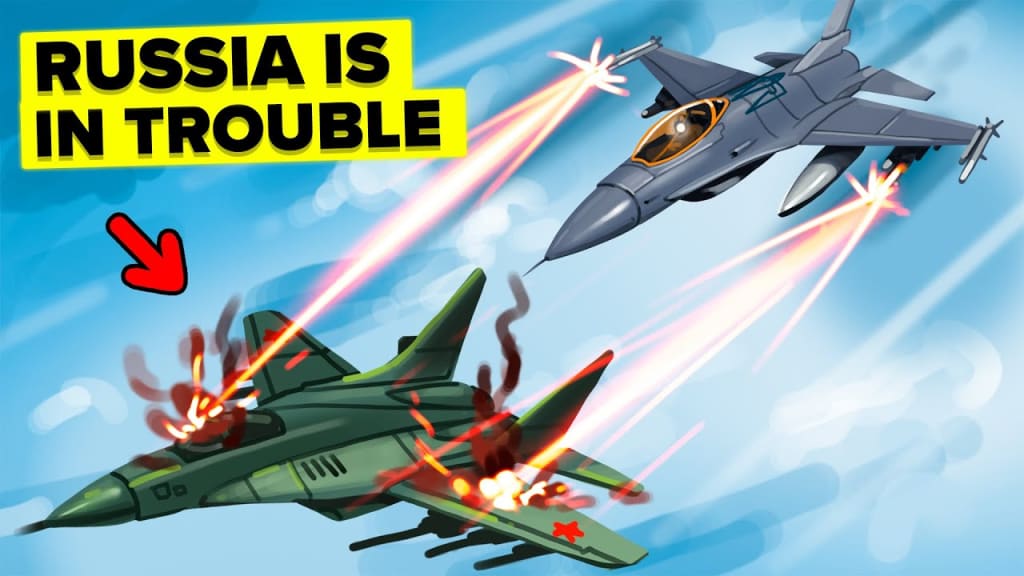How did Ukraine’s F-16 change the course of the war with Russia?
Ukraine is getting F-16s from its allies, and the war with Russia is about to heat up. The F-16 will face its old enemy, the Mig-29, in a fierce aerial battle. Which side will dominate the air space in this tense conflict? Read our latest story to find out how the F-16 will give Ukraine a powerful edge over Russia, and why Putin should be concerned 🔥🛩️💥

The F-16 Falcon vs the Mig-29 Fulcrum: Cold War Rivals Finally Meet over Ukraine
After months of debate, the United States has announced it will send F-16 fighter jets to Ukraine. This opens an exciting new chapter in the Russia-Ukraine war, as the F-16 finally goes head-to-head with its Cold War rival, the Mig-29.
The F-16 Fighting Falcon and Mig-29 Fulcrum were developed as competing air superiority fighters during the Cold War era. While they never battled it out back then, the stage is now set for these two icons of aviation history to meet at last in the skies over Ukraine.

A Long-Awaited Contest Between Bitter Rivals
The Mikoyan MiG-29 was designed in the 1970s by the Soviet Union specifically to counter new American jets like the F-15 Eagle and F-16 Fighting Falcon.
"The MiG-29 was developed in response to new American jets like the F-15 and F-16, and they would finally meet in the skies after German reunification."
After the fall of the Berlin Wall in 1989, East Germany retained a fleet of Soviet-built MiG-29s. This presented an opportunity for in-depth analysis by Western defense experts, who were eager to test the capabilities of the vaunted Fulcrum against American warplanes.
In May 1995, F-16 fighter jets from the 510th Fighter Squadron stationed in Aviano, Italy flew against Luftwaffe MiG-29s in mock combat exercises held at Decimomannu Air Base in Sardinia. This was the first time the Cold War rivals battled in the air.
Key Advantages and Weaknesses of Each Fighter
The aerial engagements highlighted strengths and weaknesses of both jets that hold true even today.
The MiG-29's Strengths
- Low-speed maneuverability - The Fulcrum's superb low-speed handling was eye-opening for American pilots. One likened fighting the MiG-29 to an aerial tango with the F/A-18 Hornet.
- Raw power - The MiG-29's twin engines give it excellent throttle response and acceleration. This allows it to regain energy faster after maneuvers.
- Helmet-mounted sight - The MiG-29 was one of the first jets with a helmet system allowing off-boresight missile shots. This gives it a huge advantage in close-range dogfights.
The MiG-29's Weaknesses
- High-speed handling - The heavier MiG-29 is less agile at high speeds compared to the light, nimble F-16.
- Situational awareness - With its cramped cockpit and limited visibility, the MiG-29 pilot has poor situational awareness compared to the F-16.
- Reliance on ground control - The MiG-29's limited radar and avionics force it to depend on ground controllers to direct it towards targets.
The F-16's Strengths
- High-speed maneuverability - The lightweight F-16 excels at fast, high-g maneuvers and dogfighting in the transonic realm.
- Superior avionics - Advanced radar, sensors, and data links give the F-16 vastly superior situational awareness and lethality.
- Survivability - The F-16's bubble canopy, ejection seat, and electronic countermeasures make it far more survivable.
The F-16's Weaknesses
- Low-speed handling - At slower speeds, the F-16 bleeds energy rapidly and can't match the MiG-29's maneuverability.
- Limited missile envelope - Without helmet cueing, F-16 pilots must keep opponents directly in front of them for missile shots.

How American Pilots Beat the Fulcrum's Advantages
F-16 pilots had to adapt their tactics to counter the MiG-29's fearsome capabilities.
"The helmet mounted sight was seen as an insurmountable challenge in close quarters dogfighting, so the F-16s were better served avoiding it all together." - Lt. Col. Gary West
They found the best strategy was to fight at high speeds above 300 knots. Here, the F-16 could use its superior thrust-to-weight ratio and energy maneuverability to outmaneuver the Fulcrums. Within these parameters, American pilots could exploit their aircraft's strengths while mitigating the MiG-29's advantage in low-speed dogfights and helmet cueing.
While the MiG-29 proved dangerous in short-range combat, F-16 pilots would extend and reset fights to remain in their jet's ideal performance envelope. The Fulcrum was designed strictly as an interceptor, not for protracted aerial engagements.
"The aircraft was formidable, but not a good dogfighter. As explained by the German operations officer of the Mig-29 squadron, the airplane was flown like a point defense interceptor, similar to the Mig-21."
The Impact of Advanced Technology on the Matchup
Since their Cold War rivalry beginnings, both aircraft have evolved tremendously. America's continual refinement of the F-16's avionics makes it an even deadlier foe today.
A Polish pilot with experience in both jets confirmed the F-16's superiority. He highlighted its ergonomic cockpit, situational awareness from radar and data links, multirole flexibility, smart missile capabilities, and extensive pilot vision as key advantages over the Fulcrum.
“While the MiG-29 was a significant aircraft in its time, it’s now a ghost of a bygone era. The F-16 meanwhile is entirely designed for efficiency, and with modern upgrades has outpaced its old Cold War rival.”
The F-16's integration into large combat networks via datalinks is a force multiplier. This allows American pilots to share sensor and targeting data, achieve excellent situational awareness, and employ long-range missiles like the AIM-120 AMRAAM and AGM-88 HARM from distances safe from the MiG-29's helmet cuing system.
While the MiG-29 remains a lethal opponent, the F-16 is no longer hobbled by the technological handicaps it faced in 1995. The Falcon's extensive modernization enables it to magnify America's traditional strengths in avionics, training, and tactics.

The F-16 Will Transform Ukraine's Air War Capabilities
The F-16's introduction in Ukraine will dramatically change the air war dynamic. After relying on old Soviet fighters and ground-based missiles, the Ukrainian Air Force finally has a NATO-standard multirole fighter capable of challenging Russia's control of the skies.
The F-16 opens up new strike options for Ukraine's pilots. The Falcon can employ long-range precision munitions like the JDAM satellite-guided bomb. When networked with NATO sensors, the F-16 can launch anti-radiation HARM missiles to suppress Russian air defenses.
"If Russian morale is low now, wait until precision cluster munitions begin raining from the skies in large number."
Ukraine urgently requires more fighters to contest Russia's numerical advantage. But the qualitative edge conferred by the F-16's sensors, data links, and armaments will help level the playing field. These force multiplying capabilities may prove decisive, just as they have helped American pilots defeat rival 'Flanker' jets flown by Russia and China.
Furthermore, the F-16 represents America's long-term commitment to Ukraine's security. As a backbone fighter of NATO air forces, the Falcon will pave the way for greater interoperability between the Ukrainian and Allied militaries.
The Cold War contest between the F-16 and MiG-29 never occurred during the Soviet era. But three decades later, these fighter jets will finally have the opportunity to prove their worth over the battlefields of Ukraine.
📝 SOURCES
- https://pastebin.com/X8GvStYQ
- Disclaimer: Images apart from the title image were generated with Bing AI, we always want to entrust our readers are not deceived.






Comments
There are no comments for this story
Be the first to respond and start the conversation.